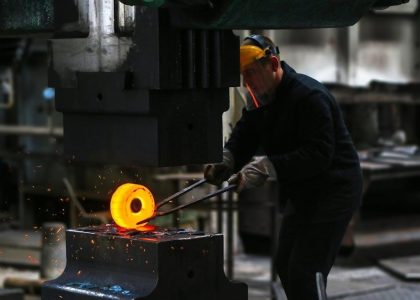Nonlinear solid mechanics involves analyzing complex material behavior under stress‚ strain‚ and deformation‚ essential for advanced engineering applications. It integrates theoretical frameworks and computational tools to solve real-world problems.
1.1 Definition and Scope of Nonlinear Solid Mechanics
Nonlinear solid mechanics examines the behavior of solids under conditions where stress-strain relationships deviate from linear elasticity‚ often involving large deformations or complex material responses. It encompasses both material nonlinearity‚ such as plasticity or hyperelasticity‚ and geometric nonlinearity due to large displacements. The scope extends to analyzing failure mechanisms‚ stability‚ and multiphysics interactions‚ providing a comprehensive framework for understanding real-world structural and material behavior in engineering‚ biomechanics‚ and advanced material science applications.
1.2 Importance of Nonlinear Analysis in Engineering
Nonlinear analysis is crucial for accurately predicting the behavior of structures under extreme conditions‚ such as high stress‚ large deformations‚ or dynamic impacts. Unlike linear models‚ nonlinear analysis captures critical phenomena like plasticity‚ buckling‚ and material failure‚ ensuring safer and more efficient designs. It is essential in aerospace‚ civil‚ and biomechanical engineering‚ enabling the simulation of real-world complexities and preventing catastrophic failures. This approach ensures reliability in modern engineering applications‚ where linear assumptions often fall short of addressing critical design challenges.
1.3 Brief History and Evolution of Nonlinear Solid Mechanics
The study of nonlinear solid mechanics traces its origins to the 19th century‚ with foundational work by Piola and Kirchhoff on continuum mechanics. The 20th century saw significant advancements‚ particularly in understanding finite deformations and material nonlinearity. Pioneers like Von Kármán and Prandtl contributed to nonlinear theories in elasticity and plasticity. The development of finite element methods in the mid-20th century revolutionized the field‚ enabling numerical solutions to complex problems. Modern advancements in computational power have further expanded the scope‚ making nonlinear analysis indispensable in engineering.

Fundamental Concepts in Nonlinear Solid Mechanics
Nonlinear solid mechanics explores complex stress-strain relationships‚ material and geometric nonlinearity‚ and energy principles governing deformation. These concepts form the foundation for analyzing advanced material behavior under various loads.
2.1 Continuum Mechanics Basics
Continuum mechanics provides the foundation for analyzing solids by treating them as continuous masses. It involves principles like stress-strain relationships‚ deformation gradients‚ and conservation laws. These concepts are essential for understanding material behavior under various loads‚ forming the basis for nonlinear solid mechanics. The framework allows engineers to model complex deformations and predict how materials respond to external forces‚ ensuring accurate simulations and designs in engineering applications. This section lays the groundwork for advanced nonlinear analyses in solid mechanics.
2.2 Stress-Strain Relationships in Nonlinear Materials
In nonlinear materials‚ the stress-strain relationship deviates from the linear elastic model. These materials exhibit complex behaviors such as plasticity‚ viscoelasticity‚ or damage evolution. The stress-strain curves are no longer proportional‚ requiring advanced constitutive models. Nonlinear stress-strain relationships are crucial for predicting material failure and deformation under extreme loads. Engineers use these models to simulate real-world material responses accurately‚ ensuring reliable designs in various industries. Understanding these relationships is vital for solving nonlinear solid mechanics problems effectively.
2.3 Material Nonlinearity vs. Geometric Nonlinearity
Material nonlinearity arises from changes in material properties‚ such as nonlinear stress-strain relationships due to plasticity or damage. In contrast‚ geometric nonlinearity stems from large deformations or rotations‚ altering the structure’s geometry and load distribution. Both types require distinct analytical approaches. Material nonlinearity is modeled using constitutive laws‚ while geometric nonlinearity involves complex equations accounting for shape changes. Understanding their differences is crucial for accurate simulations in nonlinear solid mechanics‚ ensuring realistic predictions of material and structural behavior under various loading conditions.
2.4 Energy Methods in Nonlinear Deformation Analysis
Energy methods are powerful tools for analyzing nonlinear deformation in solids. These methods utilize principles such as the potential energy principle and the principle of minimum energy to determine equilibrium states. By formulating the problem in terms of energy‚ complex nonlinear equations can be simplified. This approach is particularly useful for analyzing large deformations and stability issues. Energy methods also provide insights into the material’s behavior under external loads‚ enabling engineers to design structures with enhanced performance and reliability.

Mathematical Formulation of Nonlinear Solid Mechanics
Nonlinear solid mechanics involves complex mathematical models describing stress-strain relationships and deformation. Key principles include equilibrium equations‚ compatibility conditions‚ and constitutive laws‚ forming a comprehensive framework.
3.1 Governing Equations for Nonlinear Solids
The governing equations for nonlinear solids are derived from fundamental principles such as conservation of mass‚ momentum‚ and energy. These equations describe the equilibrium conditions‚ compatibility of deformations‚ and constitutive laws. For nonlinear behavior‚ the stress-strain relationships are complex‚ involving large deformations and material nonlinearity. Boundary conditions‚ such as applied forces or displacements‚ complete the system. Analytical solutions are often challenging‚ necessitating numerical methods like the finite element method to solve these equations effectively.
3.2 Finite Deformation Theories
Finite deformation theories describe the behavior of solids undergoing large strains and rotations. These theories extend classical mechanics to account for substantial shape changes. Key principles include the decomposition of deformation into stretch and rotation‚ and the use of strain measures like the Green-Lagrange tensor. Hyperelastic and elastoplastic models are commonly employed. These theories are crucial for analyzing materials under extreme loading conditions‚ ensuring accurate predictions of structural behavior in engineering and biomechanical applications.
3.3 Variational Principles and Weak Forms
Variational principles‚ such as the principle of virtual work‚ are foundational in nonlinear solid mechanics. They formulate equilibrium conditions using energy functionals. Weak forms generalize these principles‚ enabling the creation of finite element methods. These methods discretize complex problems into manageable equations‚ facilitating numerical solutions. Variational approaches ensure consistency with physical laws‚ making them indispensable for nonlinear analyses in engineering and material science applications. They also provide a robust framework for addressing boundary value problems with high accuracy.
3.4 Discretization Techniques for Nonlinear Problems
Discretization techniques are essential for solving nonlinear problems by dividing complex domains into finite elements. These methods‚ like finite element discretization‚ approximate continuous systems with discrete equations. They handle large deformations‚ material nonlinearity‚ and geometric nonlinearity effectively. Techniques include mesh generation and time-stepping schemes‚ ensuring numerical stability and accuracy. Discretization enables efficient computation of nonlinear behavior‚ making it a cornerstone of modern engineering simulations. These methods are widely applied in structural analysis and material modeling to predict real-world system responses accurately.

Advanced Topics in Nonlinear Solid Mechanics
Advanced topics explore complex behaviors‚ including plasticity‚ damage mechanics‚ and nonlinear dynamics. These concepts address material failure‚ fracture‚ and dynamic loading‚ essential for realistic engineering simulations.
4.1 Finite Element Methods for Nonlinear Solids
Finite element methods (FEM) are powerful tools for analyzing nonlinear solids. They discretize complex geometries into elements‚ enabling numerical solutions for stress-strain relations and material behavior under large deformations. Nonlinear FEM handles phenomena like plasticity and large strains‚ crucial for accurate simulations; Commercial software such as ABAQUS and ANSYS are widely used‚ offering robust capabilities for modeling real-world engineering problems with precision and efficiency‚ ensuring reliable results for advanced material analysis.
4.2 Plasticity Theory and Its Applications
Plasticity theory describes the behavior of materials beyond their elastic limit‚ where permanent deformation occurs. It is crucial for analyzing metal forming‚ crash simulations‚ and soil mechanics. Key concepts include yield criteria‚ flow rules‚ and hardening laws. Applications range from predicting material failure to optimizing manufacturing processes. Plasticity models are experimentally validated to ensure accuracy‚ making them indispensable in engineering design and nonlinear solid mechanics solutions. Understanding plasticity is vital for simulating real-world material responses under extreme loading conditions.
4.3 Damage Mechanics and Fracture Analysis
Damage mechanics studies the progression of material deterioration‚ while fracture analysis focuses on crack initiation and propagation. Both are essential for predicting material failure under cyclic or impact loading. Techniques involve stress intensity factors‚ energy release rates‚ and cohesive zone models. These analyses are critical in aerospace‚ civil engineering‚ and composite materials‚ ensuring structural integrity and safety. Advanced computational tools enable accurate simulations‚ aiding in the design of durable and reliable structures across various industries.
4.4 Dynamics of Nonlinear Solids Under Impact Loading
Dynamics of nonlinear solids under impact loading involves analyzing high-speed collisions and transient responses. This field studies wave propagation‚ strain rate effects‚ and material behavior under extreme conditions. Key challenges include capturing large deformations‚ inertial effects‚ and energy dissipation. Advanced numerical methods‚ like explicit time integration‚ are used to simulate these phenomena. Understanding impact dynamics is crucial for applications such as crashworthiness‚ ballistic protection‚ and earthquake-resistant designs‚ ensuring safety and reliability in critical engineering systems.

Solution Techniques for Nonlinear Solid Mechanics Problems
Nonlinear solid mechanics problems often require iterative methods to achieve convergence. Techniques like Newton-Raphson and arc-length methods are employed to solve complex equations efficiently.
5.1 Iterative Methods for Solving Nonlinear Equations
Iterative methods are essential for solving nonlinear equations in solid mechanics. Techniques like Newton-Raphson and arc-length methods are widely used to handle complex‚ path-dependent problems. These methods iteratively refine solutions until convergence is achieved. Initial guesses are critical‚ as they influence convergence speed and stability. Iterative approaches are particularly useful for material nonlinearities‚ such as plasticity‚ and geometric nonlinearities‚ like large deformations. They balance accuracy and computational efficiency‚ making them indispensable in finite element analysis and real-world engineering applications.
5.2 Newton-Raphson Method for Nonlinear Systems
The Newton-Raphson method is a powerful iterative technique for solving nonlinear systems of equations. It uses the Jacobian matrix to guide convergence toward solutions. By updating variables incrementally‚ it efficiently handles complex material and geometric nonlinearities. The method is widely applied in solid mechanics for problems like plasticity and contact. Its quadratic convergence rate ensures accuracy when initial guesses are close to solutions. However‚ careful selection of initial conditions and monitoring of iterations are crucial to avoid divergence and ensure stability in simulations.
5.3 Arc-Length Method for Path-Dependent Problems
The arc-length method is a robust numerical technique for solving path-dependent nonlinear problems. It overcomes limitations of traditional methods by dynamically adjusting load increments. This approach ensures stable convergence‚ even near limit points or during complex material behavior. By controlling the incremental step size‚ it effectively handles bifurcation and snap-through phenomena. Widely used in buckling and fracture analyses‚ the method enhances accuracy and reliability in nonlinear simulations‚ making it indispensable for advanced engineering applications.
5.4 Implicit and Explicit Time Integration Schemes
Implicit and explicit time integration schemes are numerical methods for solving transient nonlinear problems. Explicit methods‚ like central difference‚ are computationally efficient but require small time steps for stability. Implicit methods‚ such as Newmark or Hilber-Hughes-Taylor‚ offer unconditional stability‚ allowing larger time steps. Each scheme balances accuracy‚ computational cost‚ and stability‚ with choices depending on problem dynamics and material behavior. These methods are crucial for accurately simulating dynamic events in nonlinear solid mechanics‚ ensuring reliable results in complex scenarios.

Practical Applications of Nonlinear Solid Mechanics
Nonlinear solid mechanics is crucial in aerospace‚ civil‚ and biomechanical engineering‚ addressing material failures‚ large deformations‚ and dynamic impacts‚ ensuring safety and efficiency in real-world applications.
6.1 Aerospace Engineering Applications
In aerospace engineering‚ nonlinear solid mechanics is essential for analyzing complex material behavior under extreme conditions‚ such as high temperatures‚ vibrations‚ and dynamic loads. It is used to study the stress-strain relationships in advanced composites‚ predict structural integrity during impact‚ and optimize lightweight designs for aircraft and spacecraft. Finite element methods and tools like ABAQUS are widely employed to simulate nonlinear phenomena‚ ensuring safety and performance in critical aerospace applications.
6.2 Civil Engineering Applications
Nonlinear solid mechanics plays a crucial role in civil engineering for analyzing structures under extreme loads‚ such as earthquakes or heavy traffic. It is used to predict the behavior of materials like concrete and steel‚ which exhibit nonlinear stress-strain relationships. Finite element methods are employed to assess the safety and durability of large-scale structures‚ such as bridges‚ dams‚ and high-rise buildings. These analyses ensure structural integrity‚ optimize designs‚ and prevent catastrophic failures‚ making nonlinear solid mechanics indispensable in modern civil engineering projects.
6.3 Biomechanical Applications
Nonlinear solid mechanics is vital in biomechanics for understanding the behavior of biological tissues like bones‚ muscles‚ and tendons. These materials exhibit nonlinear stress-strain relationships due to their complex‚ anisotropic structures. Finite element models are used to simulate injuries‚ surgeries‚ and prosthetics‚ aiding in the design of medical devices. By analyzing the nonlinear deformation of tissues under various loads‚ researchers can improve treatments for conditions like fractures and ligament injuries‚ enhancing patient outcomes and advancing medical technology.
6.4 Industrial and Manufacturing Applications
Nonlinear solid mechanics is crucial in industrial and manufacturing processes to analyze material behavior under extreme conditions. It aids in predicting plastic deformation‚ damage‚ and failure in components like metal alloys and composites during forming and machining. Finite element simulations optimize manufacturing processes‚ reducing material waste and improving product reliability. This ensures the development of safer‚ more efficient machinery and structures‚ meeting the demands of modern industries while minimizing costs and environmental impact through precise material modeling.

Case Studies and Examples
Real-world applications of nonlinear solid mechanics are demonstrated through case studies‚ showcasing analyses of elastic beams‚ thin-walled structures‚ and metal forming processes. These examples highlight practical solutions.
7.1 Analysis of a Nonlinear Elastic Beam
The analysis of a nonlinear elastic beam involves studying its response under load‚ considering large deformations and material nonlinearity. Finite element methods are employed to simulate stress-strain distributions‚ incorporating tools like ABAQUS for accurate modeling. Boundary conditions mimic real-world scenarios‚ capturing static or dynamic loading effects. Results reveal deviations from linear behavior‚ aiding engineers in designing components for extreme conditions‚ crucial in aerospace and civil engineering applications.
7.2 Buckling of Thin-Walled Structures
Buckling of thin-walled structures is a critical nonlinear phenomenon under compressive loads‚ leading to instability and potential failure. Nonlinear analysis captures post-buckling behavior‚ essential for understanding load-carrying capacity. Finite element methods‚ such as those in ABAQUS‚ simulate these behaviors‚ considering material and geometric nonlinearities. Engineers use such analyses to design lightweight‚ efficient components for aerospace and civil engineering‚ ensuring safety and performance under extreme conditions while optimizing structural integrity.
7.3 Plastic Deformation in Metal Forming Processes
Plastic deformation in metal forming involves permanent shape changes due to stress exceeding yield limits. Nonlinear solid mechanics models capture large strains‚ anisotropy‚ and work hardening. Finite element analysis tools like ANSYS simulate forming processes‚ predicting material flow and residual stresses. Understanding these behaviors ensures precise control over product quality‚ reducing defects and material waste. Accurate modeling is vital for optimizing manufacturing processes in industries requiring high-performance metal components.
7.4 Fracture Analysis of Composite Materials
Fracture analysis of composite materials examines crack initiation‚ propagation‚ and delamination under load. Nonlinear solid mechanics models incorporate material heterogeneity and interfacial effects‚ predicting failure modes. Finite element methods simulate stress concentrations and energy release rates. Experimental validation ensures accurate modeling of fracture mechanisms‚ crucial for designing durable composite structures in aerospace and automotive industries. Advanced tools like ABAQUS enable detailed analysis‚ optimizing material performance and safety under various loading conditions.

Software Tools for Nonlinear Solid Mechanics
Software tools like ABAQUS‚ ANSYS‚ and open-source platforms enable advanced simulations‚ material modeling‚ and finite element analysis for nonlinear solid mechanics problems‚ enhancing accuracy and efficiency.
8.1 Overview of Commercial FEA Software
Commercial FEA software like ABAQUS and ANSYS provides robust tools for nonlinear solid mechanics analysis‚ offering advanced material modeling‚ geometric nonlinearity handling‚ and dynamic simulations. These platforms are widely used in industries for complex structural assessments‚ enabling engineers to simulate real-world conditions accurately. They support iterative methods and arc-length techniques for solving nonlinear equations‚ ensuring precise results. These tools are essential for industries requiring high-precision simulations‚ such as aerospace and civil engineering.
8.2 ABAQUS for Nonlinear Solid Mechanics
ABAQUS is a powerful FEA tool specialized in nonlinear solid mechanics‚ offering advanced simulation capabilities for complex material behavior and large deformations. Its robust framework handles both material and geometric nonlinearities‚ making it ideal for analyzing structures under extreme loading conditions. The software supports static‚ dynamic‚ and thermal analysis‚ enabling precise modeling of real-world engineering challenges. ABAQUS is widely used in industries like aerospace and automotive for simulating metal forming‚ crash testing‚ and impact scenarios‚ ensuring accurate and reliable results.
8.3 ANSYS for Advanced Material Modeling
ANSYS provides comprehensive tools for advanced material modeling in nonlinear solid mechanics‚ enabling accurate simulation of complex material behaviors. It supports nonlinear elasticity‚ plasticity‚ and damage mechanics‚ making it ideal for analyzing advanced composites and multi-material structures. ANSYS offers robust pre- and post-processing capabilities‚ allowing users to define custom material models and visualize results effectively. Its versatility and precision make it a preferred choice in industries like aerospace‚ automotive‚ and energy for solving challenging nonlinear material-related problems.
8.4 Open-Source Tools for Nonlinear Analysis
Open-source tools like FEniCS‚ Code_Aster‚ and CalculiX provide cost-effective solutions for nonlinear solid mechanics. FEniCS excels in PDE solving with a Python interface‚ while Code_Aster handles structural mechanics and dynamics. CalculiX offers finite element analysis for nonlinear problems. These tools are highly customizable‚ supporting complex material models and large deformations. They are widely used in research and education‚ offering flexibility and affordability for advanced nonlinear simulations‚ making them ideal for users seeking open-source alternatives to commercial software.

Challenges in Nonlinear Solid Mechanics
Nonlinear solid mechanics faces challenges like computational demands‚ experimental validation complexities‚ material parameter identification‚ and interpreting multidimensional results‚ requiring advanced algorithms and experimental techniques for accurate solutions;
9.1 Computational Challenges in Nonlinear Simulations
Nonlinear simulations present significant computational challenges‚ including the need for robust iterative solvers‚ high-performance computing resources‚ and efficient algorithms to handle large deformation‚ material nonlinearity‚ and complex boundary conditions. These simulations often require fine mesh discretization and time integration schemes to capture dynamic behavior accurately. Additionally‚ the convergence of nonlinear solutions can be sensitive to initial conditions and parameter choices‚ necessitating careful setup and validation. These challenges demand advanced computational tools and expertise to ensure reliable results.
9.2 Experimental Validation of Nonlinear Models
Experimental validation is crucial for verifying nonlinear models‚ ensuring their accuracy and reliability. Techniques like deformation measurements‚ load application‚ and strain monitoring are employed to capture material behavior under various conditions. Advanced tools such as digital image correlation (DIC) and extensometers enable precise data collection. Challenges include achieving reproducibility‚ managing material variability‚ and interpreting complex datasets. These experiments provide essential insights‚ allowing for model calibration and refinement‚ ensuring that simulations align with real-world observations and enhancing predictive capabilities in nonlinear solid mechanics applications.
9.3 Material Parameter Identification
Material parameter identification is a critical challenge in nonlinear solid mechanics‚ requiring precise determination of material constants. This involves inverse analysis‚ where experimental data is compared with model predictions to optimize parameters. Techniques such as least squares minimization and genetic algorithms are commonly used. Challenges include non-uniqueness of solutions and sensitivity to experimental noise. Accurate identification ensures reliable model predictions‚ enabling better design and simulation of structures under complex loading conditions‚ thus advancing material modeling capabilities in engineering applications.
9.4 Interpretation of Nonlinear Results
Interpreting nonlinear results requires a deep understanding of the underlying physics and mathematical models. Challenges arise from complex stress-strain relationships and path-dependent behaviors. Engineers must carefully analyze load-displacement curves‚ strain distributions‚ and energy dissipation to draw meaningful conclusions. Validation against experimental data is crucial to ensure accuracy. Effective interpretation enables the optimization of structural designs‚ enhances material performance‚ and informs safety assessments‚ ultimately advancing engineering practice and innovation in nonlinear solid mechanics applications.

Future Directions in Nonlinear Solid Mechanics
Future research focuses on integrating machine learning with material modeling‚ advancing multiscale techniques‚ and solving coupled field problems to enhance simulation accuracy and engineering design capabilities.
10.1 Advances in Material Modeling
Advances in material modeling focus on developing accurate constitutive models for complex materials‚ incorporating microstructural behavior and damage mechanisms. These models aim to predict nonlinear responses under various loading conditions‚ improving simulation accuracy for engineering applications. Integration with machine learning algorithms enhances parameter identification and optimizes material performance. Such developments are crucial for designing advanced structures in aerospace‚ biomedical‚ and energy sectors‚ enabling safer and more efficient solutions.
10.2 Machine Learning in Nonlinear Solid Mechanics
Machine learning is revolutionizing nonlinear solid mechanics by enabling data-driven modeling of complex material behaviors. Techniques like neural networks and Gaussian processes optimize material parameter identification and accelerate simulations. These methods enhance predictive capabilities for nonlinear deformation‚ damage‚ and failure. Integration with finite element methods improves solution accuracy and efficiency. Machine learning also aids in real-time structural health monitoring and adaptive design optimization‚ opening new avenues for smart engineering systems and materials.
10.3 Multiscale Modeling Techniques
Multiscale modeling techniques bridge atomic‚ microscopic‚ and macroscopic scales to analyze complex material behavior. These methods integrate detailed microstructural data with continuum-level simulations‚ enabling accurate predictions of nonlinear deformation and failure. By linking scales‚ multiscale models capture hierarchical interactions crucial for understanding material response under extreme conditions. This approach enhances simulation accuracy‚ optimizes material design‚ and provides insights into scale-dependent phenomena‚ making it invaluable for advancing nonlinear solid mechanics and engineering applications.
10.4 Coupled Field Analysis in Nonlinear Solids
Coupled field analysis in nonlinear solids examines interactions between mechanical‚ thermal‚ and electromagnetic fields. This approach captures how deformations influence and are influenced by temperature and electric fields. Advanced computational methods solve these coupled equations‚ revealing complex behaviors such as thermal expansion‚ piezoelectric effects‚ and electromagnetic-induced stresses. This technique is critical for modern applications like smart materials and energy harvesting‚ offering insights into multiscale and multiphysics phenomena in nonlinear solid mechanics.




